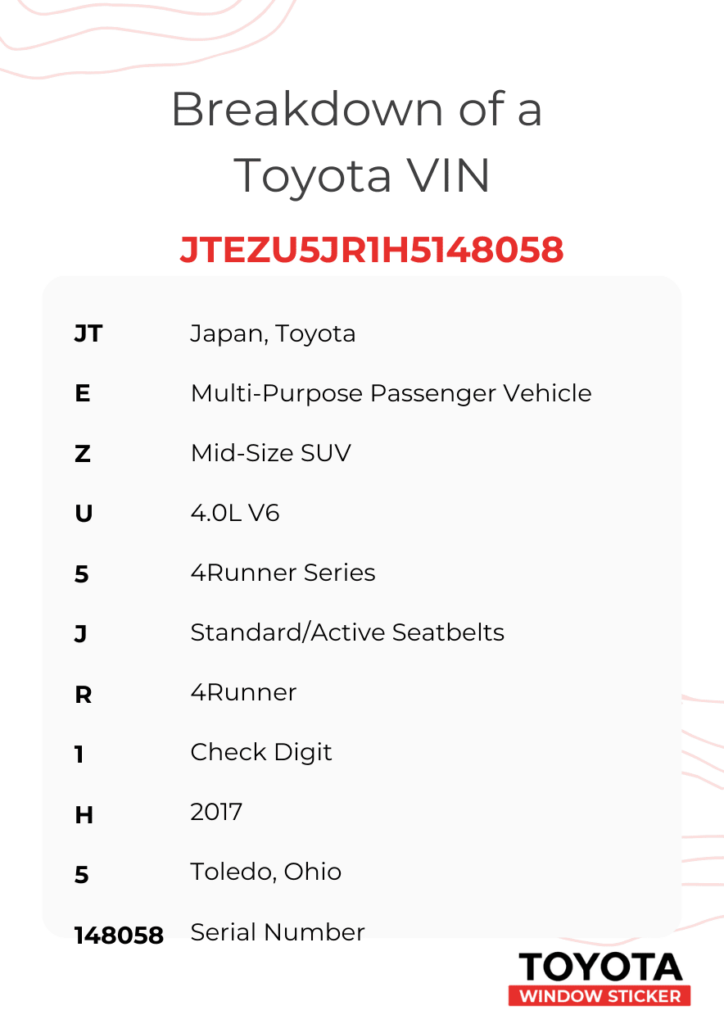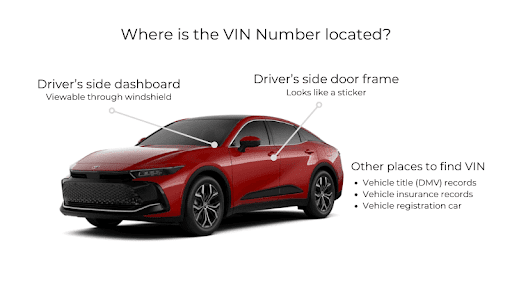Toyota VIN Number Decoder
The Toyota VIN number isn’t just a string of characters assigned to a vehicle. These characters show a vehicle’s specifications, features, production details, build info, and even history records. Learn everything about the Toyota VIN with our simple guide – from how to find the VIN and how to decode it to its uses.
What is a Toyota VIN?
A Toyota VIN is more than just a string of characters—it’s a vehicle’s unique fingerprint. Whether it’s the 17-character VIN (or 5 to 14 characters on classic models), this code unlocks a world of details about a specific Toyota.
With the VIN, you can dive into everything from the vehicle’s specifications and features (both standard and optional) to its window sticker, paint color, and build sheets. Plus, a detailed VIN lookup lets you uncover its history right down to the finest details.
This powerful code also helps you spot any red flags—whether it’s a damaged car, a vehicle with alterations, a counterfeit, or even a clone—making the process of buying and selling used cars that much safer and simpler.
Toyota VIN Number Breakdown
The VIN number is 17 characters long in modern vehicles and includes both letters and numbers except the letters Q (q), I (i), and O (o). These are omitted from the VIN to avoid confusion with the numbers 1, 0, and 9.
The characters in the VIN are also grouped into three segments to make decoding easier. These segments are:
- World Manufacturer Identifier (WMI): This includes the first three characters and signifies the vehicle’s country of origin and manufacturer.
- Vehicle Descriptor Section (VDS): This section includes the 4th to 9th characters and contains information about the vehicle’s make, engine specs, model, and more.
- Vehicle Identifier Section: Here, you will find the 10th to 17th characters, which encode details like the model year, manufacturing plant code, and a serial number unique to each vehicle.

What Does Each Character in a Toyota VIN Mean?
1st Character: Toyota Country of Origin
The first digit of the VIN indicates where the specific Toyota was manufactured. This helps identify the country of production. For most Toyota vehicles, you should see these characters as the first digit:
- 1, 4 and 5 = United States
- 2 = Canada
- 3 = Mexico
- J = Japan
- V = France
For example, this Toyota Corolla “1NXAE00E6PZ107036” was made in the U.S.
2nd Character: Manufacturer
For most manufacturers, they use one specific code, but in Toyota vehicles, you would find either “T” for Toyota or “N” for NUMMI. NUMMI was a California-based manufacturing company jointly owned by General Motors and Toyota. Here, some Corollas were built and would mostly have the letter “N” as their second character.
3rd Character: Vehicle Type or Region
The third character on a Toyota VIN number tells the vehicle type. If you find any of these characters, it should give you a clue of the vehicle’s type:
- D, G, K, X, 1, 2, 7, N = Car
- A, B, F, M, 4 = Truck
- E, L, 3 = Multipurpose passenger vehicles, SUVs, and crossovers
- 5 = Convertible
4th Character: Body Type and Drivetrain
The fourth character tells the body type and the drivetrain of the Toyota. In most Toyota cars, you will find these characters:
- A = Two-door, two-wheel drive sedan
- B = Four-door, two-wheel drive sedan
- C = Two-door, two-wheel drive coupe
- G, K = Four-door wagon, two-wheel drive
- H, L = Four-door wagon, four-wheel drive
- Z = Five-door wagon, two-wheel drive
- S = Three-door liftback four-wheel drive
For trucks, these are the characters to look out for and what they mean:
- N = Two-door, two-wheel drive
- P = Two-door, four-wheel drive
- T = Extended cab, two-wheel drive
- W = Extended cab, four-wheel drive
- E = Four-door, two-wheel drive
- B, D, L = Four-door, four-wheel drive
In other vehicles, you can check for these:
- X = SUV
- M = Five-door, two-wheel drive van
- Y = Sport van
Note that some of these characters are recycled to represent different body types and drivetrains.
5th Character: Engine
Toyota has produced numerous engines throughout its history, which means the letters and numbers for this digit are often recycled. To find out which engine was used in your car, simply use our VIN decoder.
6th Character: Vehicle Series
The vehicle series is usually encoded in the sixth character of the VIN. To decode this, you also need a VIN decoder.
7th Character: Safety Features
The seventh character shows the different types of seat belts and airbags installed at the factory.
8th Character: Model or Platform
This character identifies the model of your Toyota. For the most popular ones, you will find these characters on the eighth digit:
- 1 = Tundra
- A = Highlander, Sequoia, Celica, and Supra
- B = Avalon
- E = Corolla and Matrix
- K = Camry
- N = Tacoma and compact trucks
- P = Camry and Solara
- R = 4Runner and Corolla
- U = Prius
- V = RAV4
9th Character: Check Digit
This digit verifies that the VIN is authentic and not a fake string of random characters. It is calculated using a specific algorithm developed by the U.S. Department of Transportation.
10th Character: Model Year
The tenth character indicates the model year and alternates between numbers and letters. Each letter represents a specific year; ‘W,’ for example, signifies a Toyota from the 1998 model year.
Here’s a table that can help you easily identify any Toyota’s model year:
| Code/Year | Code/Year | Code/Year | Code/Year | Code/Year |
| A 1980 B 1981 C 1982 D 1983 E 1984 F 1985 G 1986 H 1987 J 1988 K 1989 | L 1990 M 1991 N 1992 P 1993 R 1994 S 1995 T 1996 V 1997 W 1998 X 1999 | Y 2000 1 2001 2 2002 3 2003 4 2004 5 2005 6 2006 7 2007 8 2008 9 2009 | A 2010 B 2011 C 2012 D 2013 E 2014 F 2015 G 2016 H 2017 J 2018 K 2019 | L 2020 M 2021 N 2022 P 2023 R 2024 S 2025 T 2026 V 2027 W 2028 X 2029 |
11th Character: Assembly Plant
The eleventh character shows the vehicle’s assembly or manufacturing plant, and you would mostly find Toyotas assembled in these locations represented with these characters:
- 0-9, K = Toledo, Ohio
- C = Cambridge, ON
- R = Lafayette, IN
- S = Princeton, IN
- U = Georgetown, KY
- W = Woodstock, ON
- Y = San Antonio, TX
- Z = Fremont, CA
12th to 17th Characters: Serial Number
These characters make up the unique sequential number of the Toyota. This distinguishes it uniquely from other Toyotas with the same model, trim, etc., manufactured in the same plant.
Where is the VIN Number on a Toyota?
You might be wondering where to find the Toyota VIN. The good news is that it’s easy to find since Toyota places the VIN in several locations on the vehicle, and with a good look, you should be able to find it:
Here’s where you can find the VIN number on a Toyota:
- On the dashboard of the vehicle, near the windshield
- On the driver’s side door jamb
- On the engine block
- On the vehicle’s firewall
- In the left-hand inner wheel arch
- On the steering wheel/steering column
- On the radiator support bracket
- On the car’s title, registration, maintenance book, or the auto insurance policy

What Information Can I Get from a Toyota VIN Lookup?
With the VIN and a Toyota VIN number lookup, you can learn everything about both used and new Toyota vehicles. This includes vehicle specifications, features, build sheets, and past history records.
Some Toyota specifications you can view when you decode the VIN includes:
- Year
- Make
- Exterior dimensions
- Number of doors
- Ground clearance
- Standard seating
- Transmission style
- Fuel type
- Braking
- Range extender
- Engine Description
- Front airbag information
- Emissions
- Cargo dimensions
- Model
- Valve train design
- Interior dimensions
- Suspension
- Traction battery
- Engine Size and specs
- Drive Type
- Tank capacity
- Trailering
- Displacement
- Mileage
- Tire pressure and size
- Wheels
- Electrical powertrain
- Trim
- Country
- Delivery charges
- Steering
- Weight
- MSRP
- Body type
- Seating
- EPA Class
- Engine model
- Engine configuration
- Seat belt type
- Off-road attributes
- Electrical specifications
- Year
- Make
- Exterior dimensions
- Number of doors
- Ground clearance
- Standard seating
- Transmission style
- Fuel type
- Braking
- Range extender
- Engine Description
- Front airbag information
- Emissions
- Cargo dimensions
- Model
- Valve train design
- Interior dimensions
- Suspension
- Traction battery
- Engine Size and specs
- Drive Type
- Tank capacity
- Trailering
- Displacement
- Mileage
- Tire pressure and size
- Wheels
- Electrical powertrain
- Trim
- Country
- Delivery charges
- Steering
- Weight
- MSRP
- Body type
- Seating
- EPA Class
- Engine model
- Engine configuration
- Seat belt type
- Off-road attributes
- Electrical specifications
But that’s not all. A Toyota VIN lookup also tracks vehicle history records from when the vehicle first left the factory till date. Some records you can view include:
- Mileage
- Odometer Readings
- Sales History
- Auction History
- Accident History
- Title Brand
- Salvage Title
- Hail Damage
- Flood Damage
- Structural Damage
- Ownership History
- Usage History
- Ownership Duration
- Lien & Loans
- Maintenance Schedule
- Warranty Status
- Repair Cost
- Recalls History
- Mileage
- Odometer Readings
- Sales History
- Auction History
- Accident History
- Title Brand
- Salvage Title
- Hail Damage
- Flood Damage
- Structural Damage
- Ownership History
- Usage History
- Ownership Duration
- Lien & Loans
- Maintenance Schedule
- Warranty Status
- Repair Cost
- Recalls History
Keep in mind that the records available when you decode the VIN depend on the provider you choose. For instance, with our window sticker lookup tool, you can view all the specifications listed above on a copy of the original window sticker. However, you might get less information from other providers.
How to Decode a Toyota VIN Number
If you have the Toyota VIN handy, you can decode it with our VIN decoder instantly with just a few steps:
- Enter the Toyota VIN in the form above. Our tool can decode standard VINs (17 characters) and classic VINs (5 – 14 characters). You can also use the license plate number or the year, make, and model of the vehicle if you don’t have the VIN.
- Click on ‘Search’ to preview your vehicle’s specifications for free.
- Complete the payment process to get a detailed vehicle history report showing vehicle specifications and history records.
Using our Toyota VIN decoder, you can also break down all the characters of a VIN to access the specifications and build data, whether for classic or modern vehicles.
Common Uses of the Toyota VIN Number
The VIN fits into many applications, depending on who’s using it. But you will often see the VIN used for:
Vehicle Registration
The VIN is required during, before, and after a vehicle purchase is completed. After purchase, most importantly, every vehicle has to be registered at the State bureaus or departments of motor vehicles before they can be used publicly legally. The VIN is also required for other ownership papers and documents for proper identification.
Insurance Purposes
The Toyota VIN is also required during insurance. With a Toyota VIN lookup, insurance companies can use the check on information about specific Toyotas and make accurate quotes.
Window Stickers
The VIN is very useful in generating window stickers to check any vehicle’s specifications, such as make, model, engine type, and trim. This ensures that potential buyers can verify the exact features and details of the vehicle before making a purchase.
History Checks
The VIN also comes in for buyers who need to check a vehicle’s history records like theft records, sales records, damages, accidents, salvage brands, rebuilt titles, build data, warranty coverage, and more. With a simple VIN check, car buyers, sellers, and dealers can avoid damaged cars and negotiate accurately.
Police Checks
One important and common use of the Toyota VIN is police checks. If a vehicle gets reported as stolen, the police can identify such vehicles with the help of the VIN. They can even place police markers on those VINs and get alerts whenever they are spotted at checkpoints.
Safety Recalls
Manufacturers also use the VIN to identify specific vehicle models that are recalled. With this, they can notify the owners to get their vehicles fixed as soon as possible. Car buyers can also check for pending recalls on any used car before purchasing using the VIN.
Top Models You Can Lookup With a Toyota VIN Decoder
Now that you know everything about the VIN, you need to view the specs and features of any Toyota before making a purchase. Here are some Toyota models you may be interested in:
| Land Cruiser | Tacoma | 4Runner | Avalon |
| Highlander Hybrid | RAV4 | Corolla Cross | C-HR |
| Sequoia | Sienna | Grand Highlander | Mirai |
| Prius (Hatchback) | Tundra | RAV4 Prime (Plug-in Hybrid) | Venza |
| Camry Hybrid | Corolla | bZ4X (Electric SUV) | Yaris Cross |
Frequently Asked Questions
How do you look up a Toyota VIN number?
You can look up a Toyota VIN number with a VIN decoder. All you need to do is enter the VIN into the form on this page to look it up. As soon as the form is submitted, you will get a detailed list of specifications, features, pricing, warranty information, interior and exterior colors, and more.
Can I look up my vehicle specs using the VIN number?
Yes, you can look up your vehicle specs using the VIN number. If the VIN is unavailable, you can also get the vehicle specs with the license plate number or even just the year, make, and model information.
How do you check Toyota car model year?
You can check the tenth digit of the VIN and match it to the chart on this page to view any Toyota car’s model year. You can also check the model year with our Toyota VIN number decoding tool.
Where is the VIN number on a Toyota Camry?
You can find the VIN on any Toyota Camry by checking the following locations:
- On the dashboard of the vehicle, near the windshield
- On the driver’s side door jamb
- On the engine block
- On the vehicle’s firewall
- In the left-hand inner wheel arch
- On the steering wheel/steering column
- On the radiator support bracket
- On the car’s title, registration, maintenance book, or the auto insurance policy
What is a Toyota VIN check?
A Toyota VIN check breaks down the VIN to provide the detailed history of that vehicle. This includes accident reports, theft records, ownership records, title status, and more. With a VIN check, you can be sure that you’re making an informed decision, helping you avoid purchasing a vehicle with hidden issues.

